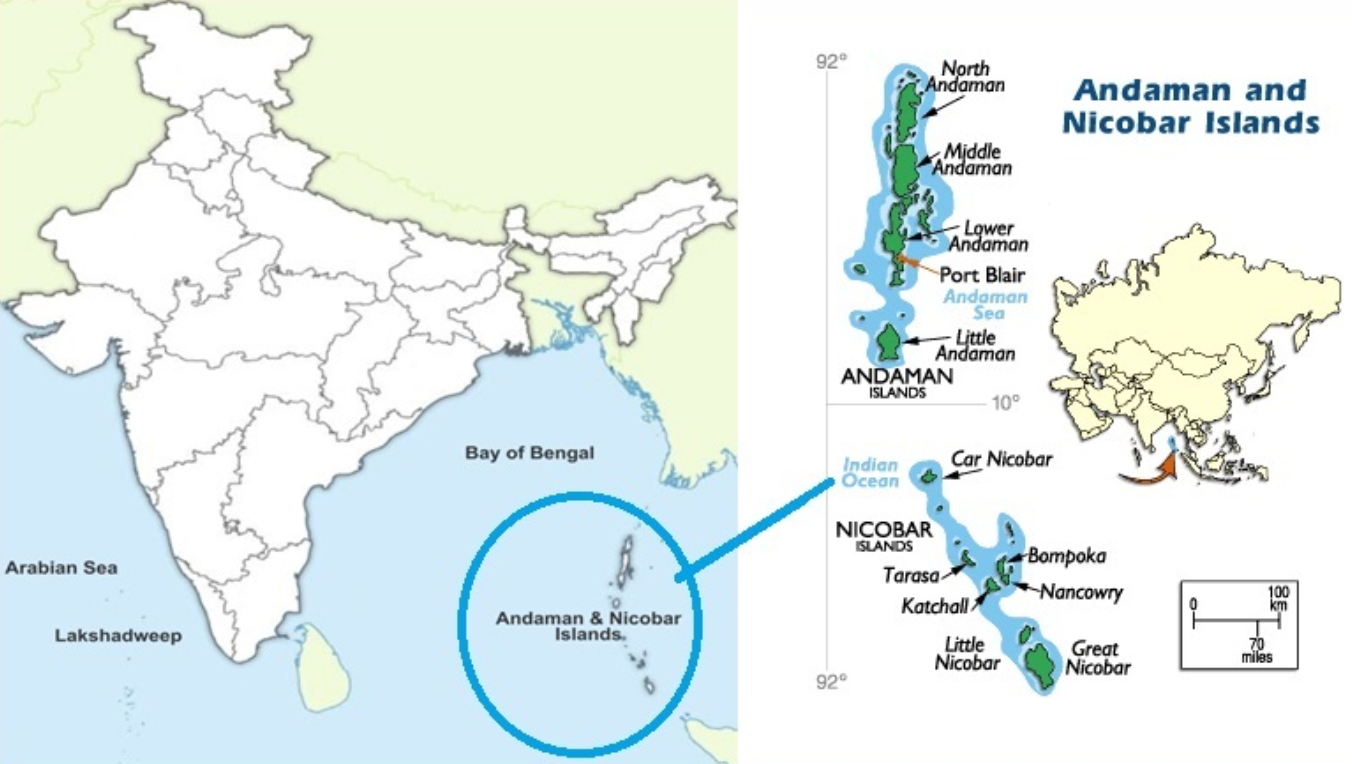The NITI Aayog has proposed to leverage the strategic location and natural features of the Little Andaman island by building a new greenfield coastal city. It will be developed as a free trade zone and will compete with Singapore and Hong Kong. This plan outlined in the ‘Sustainable Development of Little Andaman Island Vision Document’ by NITI Aayog for the fragile Little Andaman Island in the Andaman and Nicobar island group has raised alarm among conservationists.
- NITI Aayog’s proposal : 3 zones
- Importance
- Concerns
Content:
NITI Aayog’s proposal – 3 zones:
- The ‘Sustainable Development of Little Andaman Island Vision Document’ by NITI Aayog outlines the plan for developing a new city in Little Andaman island.
- The new city will have infrastructure such as ‘underwater’ resorts, casinos, golf courses, convention centres, plug-and-play office complexes, a drone port with fully automated drone delivery system, and nature cure institutes.
- An international airport capable of handling all types of aircraft is also proposed under the plan
- The only jetty on the island will be expanded and a marina will be developed next to the tourist entertainment district.
- A 100 km greenfield ring road will be constructed parallel to the coastline from east to west and will be supplemented with a mass rapid transit network with stations at regular intervals.
The new greenfield coastal city would be built along three development anchors and zones:
Zone 1:
- spread over 102 sq km along the east coast of Little Andaman
- will be the financial district and medi city and will include an aerocity, and a tourism and hospital district.
Zone 2:
- Will be the leisure zone constructed by razing 85 sq km of pristine forest
- will have a film city, a residential district and a tourism SEZ.
Zone 3:
- will be a nature zone on 52 sq km of pristine forest
- further categorised into three districts: an exclusive forest resort, a nature healing district and a nature retreat, all on the western coast.

- The Andaman and Nicobar Islands are located at the juncture of the Bay of Bengal and the Andaman Sea.
- It is a group of 572 islands, which are at the intersection of some of the busiest trade routes in the world.
- These span 450 nautical miles in a roughly north-south configuration adjacent to the western entrance to the Malacca Strait, which is itself a major Indian Ocean chokepoint.
- Geopolitically, the Andaman and Nicobar connects South Asia with South-East Asia.
- The northernmost point of the archipelago is only 22 nautical miles from Myanmar and the southernmost point (Indira Point) is about 90 nautical miles from Indonesia.
- The islands dominate the Bay of Bengal, the Six Degree and the Ten Degree Channels that more than sixty thousand commercial vessels traverse each year.
- The Andaman and Nicobar Islands constitute just 0.2% of India’s landmass but provide near 30% of its Exclusive Economic Zone.
Importance of this project:
- The islands are situated in a strategic location in the Indian Ocean Region (IOR). Therefore they are critical for India’s security.
- These islands have the potential to become an important element of India’s “Act East Policy” of engaging with countries in the East Asia region.
- The Andaman and Nicobar chain of islands could be used as a basis for Indian maritime power projection into the Indo-Pacific and even beyond into the south-west Pacific.
- They could be used for India’s Third Fleet and the trans-shipment hub. This could potentially be a strategic game-changer, rivalling the ports of Singapore or Colombo.
- Thus, better infrastructure and connectivity will help India enhance its economic and defence capabilities in the islands.
Concerns about the project:
- Divisional Forest Officer, Little Andaman, raised serious concerns about this vision on grounds of ecological fragility, indigenous rights and vulnerability to earthquakes and tsunamis.
Earthquake Vulnerability
- The islands are located in Seismic Zone V, part of the world’s most active seismic regions.
- Here earthquakes are regular occurrences and the 2004 tsunami was caused by an earthquake not far from the Nicobar Islands.
- Tourism will be the first and the worst affected in case of calamities like earthquakes, tsunamis and cyclones, which occur here regularly.
Rights of indegenous communities
- Little Andaman Island is home to the indigenous Onge community.
- Andaman and Nicobar Protection of Aboriginal Tribes Regulation (ANPATR) that was promulgated in 1956.
- Significant areas of the islands have been protected under this regulation for indigenous communities like the Jarawa and the Onge.
- In 1964-65, the entire Little Andaman island was a tribal reserve and the Onge the sole residents on the island.
- Half a century of ‘development’ later, the Onge Reserve is roughly 30% smaller (more than 200 sq. km of forest has been handed over for settlements, plantations, agriculture).
- For every Onge on Little Andaman there are now about 200 individuals from outside.
Ecological Fragility
- The coast of Little Andaman is one of the most important nesting sites of the globally endangered Giant Leatherback sea turtle
- The nature resort complex proposed at West Bay could disrupt the breeding of these endangered species.
- The theme resorts, floating/underwater resorts, beach hotels, and high-end residential villas in this secluded and difficult to reach part could have disastrous consequences on the ecology of the island.
- Also, providing drinking water for large settlement is a big challenge in many of the islands.
- Introduction
- Location and importance of Andaman and Nicobar Islands
- Write about how the project wants to use these advantages
- Mention the concerns related to the project
- Conclusion
















